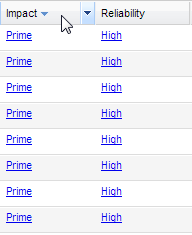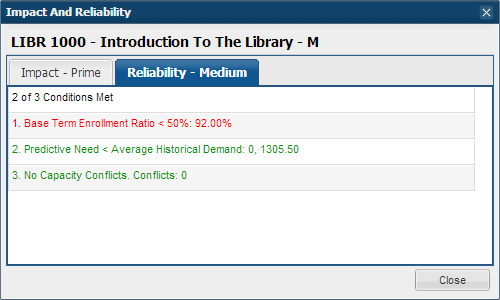
Finding the Pearls - Impact and Reliability |

|

|

|
|
Finding the Pearls - Impact and Reliability |

|

|

|
|
|
||
The analysis process calculates an impact rating and a reliability rating to provide insight into the reliability and criticality of the addition, reduction, and elimination candidates. These key pieces of information highlight the highest impact changes to be made (the "pearls"). A change recommendation that is both highly reliable AND has critical impact is considered a high impact change to the schedule.
The system arrives at these ratings by performing a series of validation tests. The ratings are assigned based on the number of test conditions that are met by each recommendation. The tests performed and their corresponding ratings are outlined below.
The tests performed to determine the impact of addition candidates include:
•Critical Student Count > Supply
Students for whom the course is a 100% requirement
•Likely Student Count > Supply
Students that are at least 50% likely to take the course
•Seat Differential >= 50
Seats offered vs. demand
Based on these tests, a rating is assigned as follows:
•Critical = Critical student count condition met
•Prime = Likely student count condition met (not critical)
•Moderate = Seat differential condition met
•Marginal = No conditions met
The tests performed to determine the reliability of addition candidates include:
•Base term enrollment ratio >= 95%
•Historical enrollment high point significantly > supply (>10)
•Predictive need significantly > supply (>10)
•Predictive need > average historical demand
•High capacity conflict count (>10)
Based on these tests, a rating is assigned as follows:
•High = All 5 conditions are met
•Medium = ((1 or 2) and (3 or 4 or 5)) are met
•Low = All others
The tests performed to determine the impact of reduction candidates include:
•Historical net sections and analysis term sections < 0
•Program need <= Historical need
•Historical seat fill < 90%
The tests performed to determine the impact of elimination candidates include:
•Program need is 0
•Likely student count is 0
•Pure requirement student count is 0
Based on these tests, a rating is assigned as follows:
•Prime = 3 conditions are met
•Moderate = 2 conditions met
•Marginal = 1 or 0 conditions met
The tests performed to determine the reliability of reduction and elimination candidates include:
•Base term enrollment ratio < 50%
•Predictive need < Average historical demand
•No capacity conflicts
Based on these tests, a rating is assigned as follows:
Reduction ratings:
•High = All conditions are met
•Medium = 2 conditions are met
•Low = 1 or 0 conditions are met
Elimination ratings:
•High = Conditions #2 and #3 are met
•Medium = Conditions #2 or #3 are met
•Low = 0 conditions are met
When viewing the analysis results course lists, columns are provided for both the Impact and Reliability rating for each course recommendation in the list.

You can sort on either of these columns by clicking the header.

Additionally, you can use the filter options on the left side of the grid to filter the results list to show only specific ratings. This is a great way to display only the high impact changes for review.

Both the Impact and Reliability rating can be clicked to review the tests performed and the pass/fail status of each.
